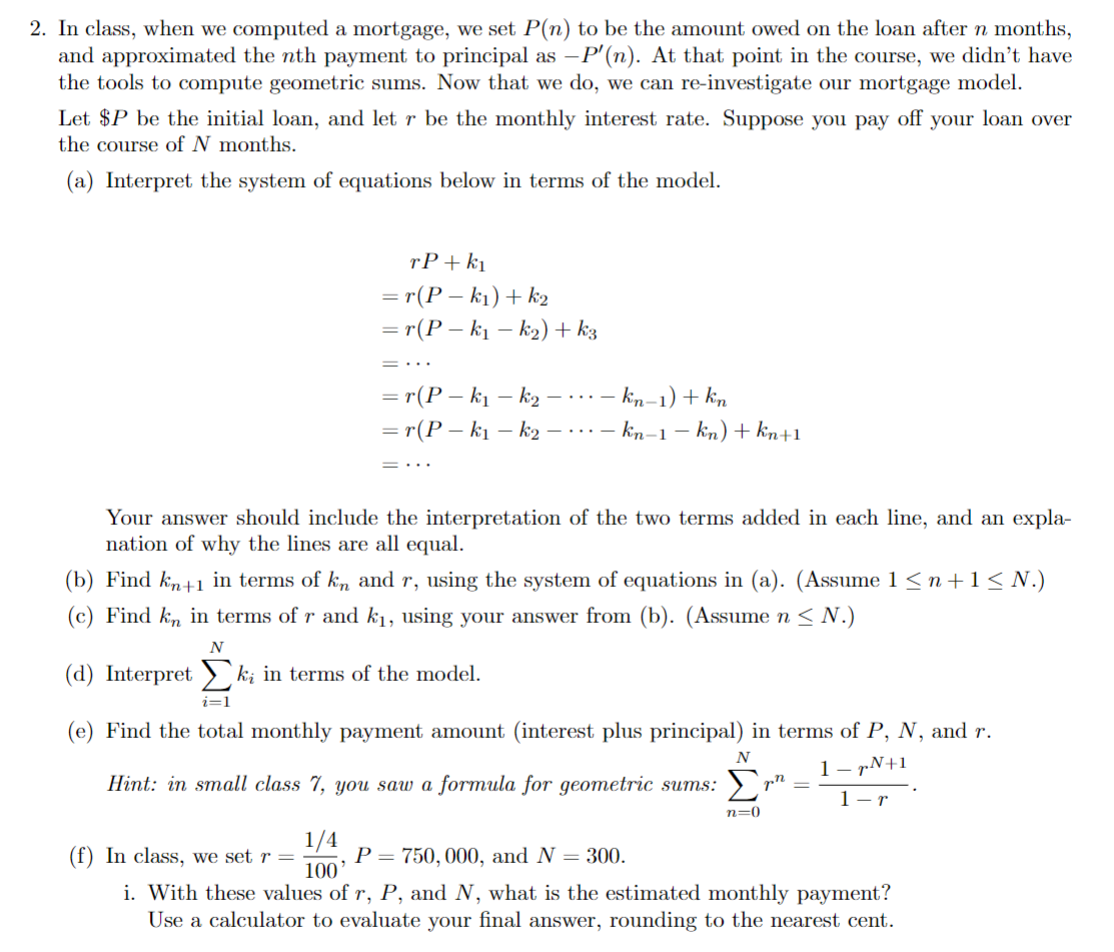

2. In class, when we computed a mortgage, we set P(n) to be the amount owed on the loan after n months, and approximated the nth payment to principal as P(n). At that point in the course, we didn't have the tools to compute geometric sums. Now that we do, we can re-investigate our mortgage model. Let $P be the initial loan, and let r be the monthly interest rate. Suppose you pay off your loan over the course of N months. (a) Interpret the system of equations below in terms of the model. ======rP+k1r(Pk1)+k2r(Pk1k2)+k3r(Pk1k2kn1)+knr(Pk1k2kn1kn)+kn+1 Your answer should include the interpretation of the two terms added in each line, and an explanation of why the lines are all equal. (b) Find kn+1 in terms of kn and r, using the system of equations in (a). (Assume 1n+1N.) (c) Find kn in terms of r and k1, using your answer from (b). (Assume nN.) (d) Interpret i=1Nki in terms of the model. (e) Find the total monthly payment amount (interest plus principal) in terms of P,N, and r. Hint: in small class 7, you saw a formula for geometric sums: n=0Nrn=1r1rN+1. (f) In class, we set r=1001/4,P=750,000, and N=300. i. With these values of r,P, and N, what is the estimated monthly payment? Use a calculator to evaluate your final answer, rounding to the nearest cent. ii. In class, we approximated the estimated monthly payment to be $3553.60. Using a mortgage calculator online, determine which seems to fit actual practice better: $3553.60, or the value from (f). (Your calculator may ask for the yearly interest rate, which would be 4112=3 percent.) 2. In class, when we computed a mortgage, we set P(n) to be the amount owed on the loan after n months, and approximated the nth payment to principal as P(n). At that point in the course, we didn't have the tools to compute geometric sums. Now that we do, we can re-investigate our mortgage model. Let $P be the initial loan, and let r be the monthly interest rate. Suppose you pay off your loan over the course of N months. (a) Interpret the system of equations below in terms of the model. ======rP+k1r(Pk1)+k2r(Pk1k2)+k3r(Pk1k2kn1)+knr(Pk1k2kn1kn)+kn+1 Your answer should include the interpretation of the two terms added in each line, and an explanation of why the lines are all equal. (b) Find kn+1 in terms of kn and r, using the system of equations in (a). (Assume 1n+1N.) (c) Find kn in terms of r and k1, using your answer from (b). (Assume nN.) (d) Interpret i=1Nki in terms of the model. (e) Find the total monthly payment amount (interest plus principal) in terms of P,N, and r. Hint: in small class 7, you saw a formula for geometric sums: n=0Nrn=1r1rN+1. (f) In class, we set r=1001/4,P=750,000, and N=300. i. With these values of r,P, and N, what is the estimated monthly payment? Use a calculator to evaluate your final answer, rounding to the nearest cent. ii. In class, we approximated the estimated monthly payment to be $3553.60. Using a mortgage calculator online, determine which seems to fit actual practice better: $3553.60, or the value from (f). (Your calculator may ask for the yearly interest rate, which would be 4112=3 percent.)








